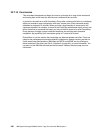
Chapter 24. Global Mirror interfaces 303
24.3.1 Establish a Global Mirror environment
The following sections discuss the setup of a Global Mirror environment using TSO
commands in a step-by-step approach. The sequence of steps in our example is the
recommended one, although it is not a mandatory one. Still, it guarantees a clean and
straightforward creation of the Global Mirror environment.
24.3.2 Define paths
When you establish Global Copy relationships between volume pairs, you have to first
establish the Global Copy paths. A Global Copy path, similar to a Metro Mirror path, is the
logical definition of the connectivity between two LSSs, the primary LSS and the secondary
LSS. This definition is accomplished upon an available physical Fibre Channel link that
connects the primary and secondary storage disk subsystems where the corresponding LSSs
are. More than one path can be defined over a single Fiber Channel link. You can also define
paths in either direction on the very same physical link.
The FCP links that provide the physical support for the logical path definitions are either
direct-connected or can use the SAN infrastructure. In the latter case, the FCP ports can be
shared with either other remote copy connections or with host connections. Still, you may
consider dedicated ports, thus separating host I/O from remote copy I/O, which is
recommended for Metro Mirror. For Global Copy and Global Mirror it is feasible to consider an
FCP port sharing approach.
Figure 24-2 shows two LSSs, one on each storage disk subsystem, with both storage disk
subsystems connected either directly or over the SAN. The figure shows four physical links,
each link connecting to an FCP port. Because the storage disk subsystems are separated
over a large distance, these links are either going through an SAN network, or over an
IP-based network. There is no distance limit for a Global Mirror configuration.
Figure 24-2 Paths definition between two LSS
Example 24-9 shows the TSO command that is used to define the four logical paths, at once,
between the primary LSS and the secondary LSS. If using TSO commands, there is no
change in how to define a path on the DS6000 or the DS8000, as compared to the ESS 800.
Example 24-9 Define logical paths
//* ---------------------------- TSO ------------ CREATE (1) ----- ***
//* ESTABLISH PATH(S) ***
//* -------------------------------------------------------------- ***
FCP port
Fiber Channel links
physical connections
DWDM or Channel Extender
network
infrastructure
LCU: 2C00
Primary
A
2C00
LCU: 3C00
Secondary
B
3C00
paths
between LSSs
logical connections


















